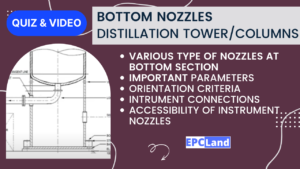
1. What distinguishes hanger supports from resting spring supports?
Why are hanger supports considered elevated guardians in the piping world?
Explanation: Hanger supports are considered elevated guardians because they suspend pipes from above, providing clearance over obstacles and maintaining access to components.
2. What feature allows for fine-tuning of the support height in hanger supports?
Why is adaptability crucial for hanger supports in accommodating changes in pipe position?
Explanation: Adaptability in hanger supports is achieved through turnbuckles or spring adjustments, allowing for fine-tuning of the support height to accommodate changes in pipe position.
3. What types of movement needs do hanger supports cater to?
How do rigid hangers, variable spring hangers, and constant spring hangers differ in their functionality?
Explanation: Hanger supports cater to a range of movement needs, offering options for rigid, variable, or constant spring supports. Rigid hangers provide stability, while variable and constant spring hangers offer flexibility.
4. How do hanger supports connect to the pipe?
Why is a secure grip important in the connection methods of hanger supports?
Explanation: Hanger supports connect to the pipe using clevises, U-bolts, or pipe clamps to ensure a secure grip, preventing unwanted movement or slippage.
5. Where do hanger supports shine in piping systems?
How do hanger supports contribute to maintaining clearance and preventing interference in above-ground piping?
Explanation: Hanger supports shine in above-ground piping by providing support for pipes that run overhead, maintaining clearance below and preventing interference with other components or activities.
6. In what situations can hanger supports be particularly useful?
How do hanger supports accommodate pipes with bends, changes in direction, or multiple branches?
Explanation: Hanger supports can be particularly useful in complex piping configurations, accommodating pipes with bends, changes in direction, or multiple branches where traditional supports might not be suitable.
7. How do hanger supports contribute to vibration isolation?
Why is suspending pipes from above beneficial in protecting sensitive equipment and instruments?
Explanation: Hanger supports contribute to vibration isolation by suspending pipes from above, isolating them from vibrations transmitted through the supporting structure and protecting sensitive equipment and instruments.
Don’t Miss 20+ Quizzes on Pipe Supports:
Short Article on Hanger Supports: Pipe Supports
Hanger Supports: Suspended Champions of Pipe Stability
Hanger supports are the suspended heroes of the piping world, providing a lifeline for pipes that need support from above. These versatile supports can accommodate various movement needs, from rigid stability to flexible adaptation, ensuring the smooth operation of piping systems.
Key Features:
- Elevated guardians: Unlike resting spring supports that cradle pipes from below, hanger supports offer a different perspective, suspending the pipe from a structure or concrete beam. This elevated position allows for clearance over obstacles, maintaining access to valves, flanges, and other components.
- Adjustable companions: Hanger supports come equipped with adjustable mechanisms, typically turnbuckles or spring adjustments, allowing for fine-tuning of the support height. This adaptability is crucial for accommodating changes in pipe position due to thermal expansion, contraction, or equipment maintenance.
- Versatile personalities: Hanger supports cater to a range of movement needs, offering options for rigid, variable, or constant spring supports. Rigid hangers provide unwavering stability, while variable and constant spring hangers accommodate movement with varying degrees of flexibility.
- Connection options: Hanger supports connect to the pipe using clevises, U-bolts, or pipe clamps. These connection methods ensure a secure grip, preventing unwanted movement or slippage.
Where Hanger Supports Shine:
- Above-ground piping: Providing support for pipes that run overhead, maintaining clearance below and preventing interference with other components or activities.
- Complex piping configurations: Accommodating pipes with bends, changes in direction, or multiple branches where traditional supports might not be suitable.
- Vibration isolation: Suspending pipes from above can help isolate them from vibrations transmitted through the supporting structure, protecting sensitive equipment and instruments.
- Accessibility management: Enabling access to valves, flanges, and other components for maintenance or inspection by providing clearance above the supported pipe.
Hanger Support: A Versatile Solution for Elevated Piping Needs:
Hanger supports are the versatile champions of elevated piping systems. They provide stability, adaptability, and accessibility, ensuring the smooth operation of pipes that need support from above. So, the next time you look up and see a pipe gracefully suspended, remember the hanger support, the silent guardian working tirelessly to keep everything in place.
Table of Contents
Don’t miss the Course on Effective Isometrics Management: Check Now
Enrollment Link
Recommended courses (Published on EPCLand)
- Complete Course on Piping Engineering
- Basics of Piping Engineering
- Piping Layout Engineering
- Piping Material Engineering
- Piping Stress Analysis
- Material Requisitions
- Piping Material Specifications
- Valve Material Specifications
- Plant Design & Layouts-OISD 118
- Isometric Management
Library of Technical Articles
Don’t miss out the collection of 15+ articles on following topics:
- Basics of Oil and Gas Industry
- Valves
- Testing
- Tank
- Piping Bulk Items
- Pipe
- Metallurgy
- Piping Materials
- Layout
- Instrumentation
- Heat Exchanger
- Type of Contracts
- Codes and Standards
- ASTM Standards
- Articles on Piping Specialty Items
Video details of Complete Course on Piping Engineering
Why Enroll in the EPCLand
Proven Track Record– PTR
Activities & Achievements before launching EPCLand
- Published more than 50+ short courses
- 3000+ Enrolments
- More than 3,500,00 Minutes of watch hours in the last 2 years
- 4000+ Students in 100+ Countries
- Rating of 4+ out of 5
- 1000+ YouTube Videos
- 8K+ Subscribers
What Students will Learn
- Codes & Standards of the Energy Sector
- Piping Material Engineering
- Piping Layout Engineering
- Stress Analysis
Interesting facts
- All the published courses have been developed by Industry Experts with more than 2 decades of experience
- Content is based on Practical experience and real-time problems.
- Content is designed and organized in such a manner that it can be easily grabbed.
- Complete website, Blogs and Quiz sections are Planned, Designed and published by myself (About me: Atul Singla)
- Complete flexibility of Time & Location, Students can access the content from anywhere & anytime
- Moreover, once enrolled, the content can be access as many times as you want, which helps in understand the fundamentals in a better way.
Conclusion
In conclusion, our courses are meticulously crafted by industry experts with over two decades of hands-on experience. The content is rooted in practical knowledge, addressing real-time problems. The material is thoughtfully designed and organized for easy comprehension. Every aspect, from the website to blogs and quizzes, has been planned, designed, and executed by Atul Singla, ensuring a comprehensive and seamless learning experience. With the flexibility of accessing the content at any time and from any location, students have the freedom to learn on their terms. Furthermore, enrollment grants unlimited access, allowing learners to revisit the material as often as needed, fostering a deep understanding of the fundamentals.



